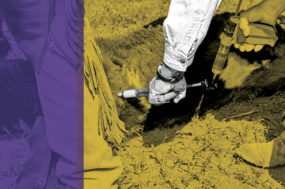Although he does not give birth to or nurse the individual calf, he does contribute half of the genetic makeup of multiple calves and influences how early in the season calves are born.
Given this, the bull has a significant impact on the success of the herd.
To ensure the maximum positive impact, each bull should undergo a breeding soundness evaluation (BSE) performed by a professional veterinarian when a bull is purchased and before the breeding season begins.
It is much better to learn a bull has suboptimal or no fertility before the breeding season begins as compared to after calving season when calves are born late or not at all.
Sterile bulls or those with suboptimal fertility can lead to significant economic impacts, along with wasted time and breeding opportunity.
While sterile bulls will not impregnate cows, suboptimal bulls may get cows pregnant, but the pregnancy is achieved much later in the breeding season.
This leads to younger, lighter-weight calves at market time. The economic value and return of utilizing a BSE has been estimated over the years, and values can be as high as $25 saved per $1 invested and $17 per cow the bull will service.
Although it is a major component, the BSE is more than just looking at the bull’s sperm. The evaluation consists of three basic components: a physical exam including the internal and external reproductive organs, scrotal circumference measurement and semen evaluation.
Physical fitness
The physical exam is a core component of the BSE. The bull must be able to identify cows in heat and must physically be able to go to the cow and mount.
If the bull is unable to do these things, the semen quality is irrelevant.
The bull’s vision is evaluated, as this is a key way that bulls recognize activity that indicates a cow is receptive.
An examination of the structural soundness of the bull’s feet and legs allows producers to gauge the bull’s ability to not only find food and water but to go to and mount the cow.
If he is in pain, he may be reluctant or even physically unable to accomplish this. Additionally, the structural correctness of the bull may also give the producer an indication of the bull’s longevity in the herd.
The bull’s reproductive anatomy also is evaluated during the physical exam. Internally, structures such as the vesicular glands, prostate, ampulla of the vas deferens and the urethra are examined for soundness.
Externally, evaluations of the prepuce, penis and scrotum are made. Abnormalities that can be found here would include persistent frenulum, penile fibromas and warts, hair rings, scars or even penile deviations. All of these problems could lead to suboptimal fertility.
A crucial measurement
Scrotal circumference is a measurement of the distance around the scrotum at its widest point. Certain minimums have been determined to be necessary for optimal breeding soundness and depend on the age of the bull.
Scrotal circumference has been linked to sperm count and quality, and a link has been established between scrotal circumference and the age at onset of puberty in that bull’s daughters.
While measuring the scrotum, the person performing the evaluation also should look for several other key indicators of breeding soundness.
The shape, size and consistency of the testicles are noted, and the epididymis is evaluated. Any abnormality here may alert the evaluator of a problem.
Sperm quality
Next, the semen quality is evaluated. Usually, semen is collected with the use of an electro-ejaculator. A probe is inserted into the rectum of the bull.
This probe delivers electronic stimulation of the nerves that control erection and ejaculation. While the bull is being stimulated, an examination of the penis usually is conducted.
Once the semen is collected, it is evaluated to determine how many sperm are moving in a forwardly progressive manner and how many have a normal shape.
There are minimum percentages established for each of these measurements. The actual number of sperm is not usually determined.
Breeding soundness
Once all of these factors have been evaluated, the bull is classified as a satisfactory potential breeder, an unsatisfactory potential breeder or as deferred.
Deferred means the bull should be evaluated again at a later date due to a problem that may be able to be corrected.
One component the BSE does not usually evaluate is the bull’s libido or his desire to mate. This is one reason why the term “potential” breeder is used in the different classifications.
It also is important to remember this is an evaluation of the bull at a specific time point and is the best estimate of fertility at that time.
It does not guarantee his continued fertility into the future. Obviously, if the bull becomes ill or injured, his fertility may be affected.
Factors that may or may not be obvious can change from one moment to the next – and certainly from year to year. Thus, there is a need for a BSE to be done before each breeding season.
Conclusion
Given the economic impacts breeding soundness has and the complexity of the evaluation, it is key to have a professional veterinarian who is familiar with the process do the evaluation.
Conducting these evaluations when a new bull is purchased and at the beginning of each breeding season can save producers time, money and headaches by providing needed information earlier. ![]()
PHOTO
The breeding soundness evaluation (BSE) is a key tool to assessing the bull’s reproductive anatomy long before the calf crop comes in. Photo courtesy of Progressive Cattleman staff.

James Little, DVM
Director of Professional Services
Neogen Corporation






